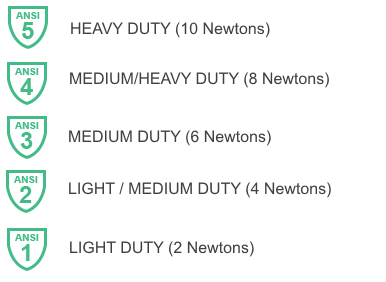WHAT TEST IS DONE FOR NEEDLE STICK GLOVES
Why is a glove that scores well for Puncture resistance tested to the European standard for mechanical handling EN388
not suitable for hypodermic needle resistance?
The European test for PUNCTURE uses a metal stylus which is similar to a large nail,
the force required to BURST the fabric denotes the score achieved 1 up to 4,
4 being the highest level of Puncture resistance.
The stylus used is nothing like a hypodermic needle, which are designed to puncture skin,
At Gloves n Stuff we only sell needle protection gloves and sleeves which have been tested with a 25 gauge needle.
This is the American test (ANSI/ISEA ASTM Hypodermic needle puncture test) which has been performed on all the products we sell.
If a product has not been tested to this standard, and we have the tests to verify it, we won't put
them on our Needle Resistant product page.
The risks posed from handling contaminated needles and sharps is too great to take any chances.
Although we only sell products tested with actual hypodermic needles, please be aware that the manufacturers state they are Needle Resistant, not Needle Proof and you will need to do a full risk assessment to ensure they are suitable.
Anti-Syringe & Needle Protection Gloves
The gloves and gauntlets in this category are all designed to prevent hypodermic needles from penetrating the glove.
What level of protection do I need?
There are two standards used for puncture resistance:
1. EN 388:1994
This standard of protection is for larger, blunt objects. This standard is good for industries like waste collection, metal fabrication and construction.
2. ASTM F2878
The ASTM F2878 standard was introduced in 2016 and is a protection standard test that measures how many Newtons of force it takes to pierce the material of a glove, the test uses a gauge which is the size of a hypodermic needle.
The standard of protection really depends on what hazards you are facing.
The higher level of protection the less dexterity you will have.
ANSI Fine Puncture Levels


Protection from needles for a variety of professionals.
Hypodermic needles pose a life-threatening safety risk to health care professionals, law enforcement officials, sanitation workers, and others, due to risk of infection from blood-borne pathogens such as HIV and hepatitis C.
Glovesnstuff supply all professions with the very best and most appropriate anti-syringe glove for the task at hand.
For the first time, the ANSI/ISEA 105-2016 have adopted a standard for hypodermic needle puncture resistance. ASTM F2878-10 Standard Test Method for Protective Clothing Material Resistance to Hypodermic Needle Puncture, addresses the unique mechanics of needlesticks and has been established as the standard for ANSI/ISEA 105-2016.
The ASTM F2878-10 test method uses a 25 gauge needle to determine the force required for a hypodermic needle to penetrate protective clothing or material. The puncture probe (25 gauge needle) travels at a 90 ̊angle into a specimen at a velocity of 500mm/min. Results are reported in Newtons on a scale of 1-5. (see table above)


